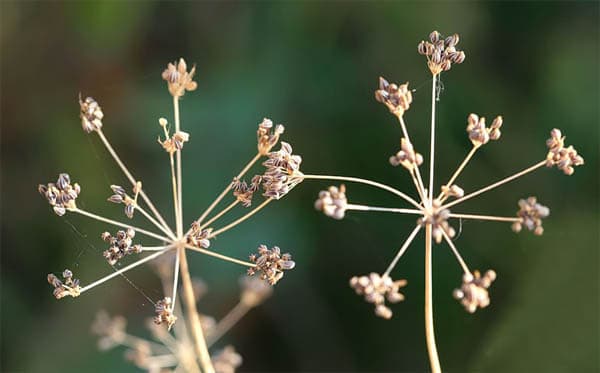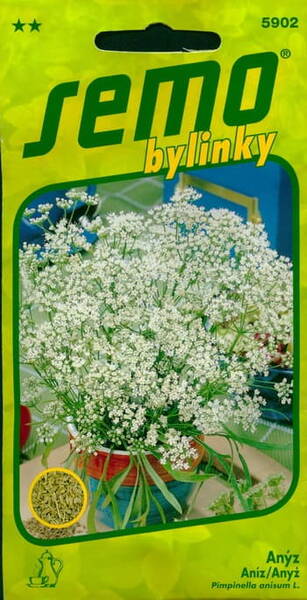Small white flowers are collected in an umbrella inflorescence.
Medicinal annual herbaceous plant from the Umbelliferae family with an upright branched stem, 20-50 cm high, covered with a short down. The leaves are alternate, the lower ones are entire, long-petiolate, rounded kidney-shaped or heart-shaped. The flowers are small and white, in complex umbrellas.
Blooms from June to September. Prefers sunny areas and sandy or loamy soils.
Mature anise fruits are used, which contain essential oil. Preparations from anise fruits delay putrefaction and fermentation processes in the intestines, relieve spasms of the abdominal organs, inhibit the development of microbes in the renal pelvis and bladder, and have expectorant and diuretic properties. Anise fruits are brewed like tea.
1 gram = 2100 seeds.


In the climatic conditions of Estonia, it is grown in open ground without any problems.
Seeds are sown in open ground in spring. Requires light soils.
The fruit is a seed, splitting into 2 halves.
Usage: leaves are used as a spicy seasoning for various dishes, seeds in bread baking, fish and meat dishes and for confectionery.
Please note that ... spicy anise seeds have a sweetish taste and a peculiar aroma, thanks to essential oils, the main component of which is anethole, which promotes better digestion.
Anise seeds are similar in use to cumin. Anise tea is very helpful for young children with coughs.
Anise is a good honey plant that attracts pollinating insects to your garden.
Pharmacy name: anise fruit - Anisi fructus (formerly: Fructus Anisi), anise oil - Anisi aetheroleum (formerly: Oleum Anisi).
Botanical description. This annual herbaceous plant reaches a height of about 50 cm and is fixed in the soil with a spindle-shaped root. The round stem branches at the top. Lower leaves with petioles, undivided, serrated; in the middle part of the stem they are three-lobed, and in the upper part they are twice or thrice pinnately dissected. Inflorescences - 7-15-rayed umbels, without involucre or with only one bract. Umbrellas, bearing small white flowers, on the contrary, most often have several leaves in the wrapper.
Blooms from July to September.
Anise has an oriental origin. It is widely cultivated in India, as well as in Western Europe (especially in the Mediterranean). Anise culture did not bypass America. In Germany, he can be found in gardens, from where he now and then "runs away" and then runs wild. Must be carefully identified - can be confused with other poisonous umbrellas.
Harvesting. Anise is harvested exclusively on cultivated plantations. When the fruits are fully ripe, the plants are torn or cut, dried in the air and threshed. The round-ovoid fruits of anise, like all umbrella ones, consist of two fruitlets, but they do not always break up into them.
Active substances. The pleasant aroma of anise fruits is due to essential oil, which is good material that contains up to 2-3%. The main component of this essential oil is trans-anethole. In addition, anise fruits contain a lot of fatty oil, sugar and protein.
Healing action and application. Anise relieves flatulence, strengthens the stomach and helps with coughing. Despite such, it would seem, popularity, we have to admit that anise always remains "on the sidelines." Among the remedies for bloating from the umbrella family, cumin is more effective, and fennel should be preferred against anise cough. Nevertheless, in both cases, do not refuse anise either in the form of tea or in the form of various herbal preparations (anise drops). But, perhaps, in the first place is still used for coughing.
Tea from anise: 1 teaspoon with the top of the fruit, which must first be ground or crushed (preferably in a mortar), pour 1/4 I of boiling water and filter after 10 minutes. From cough, they drink 2-5 times a day for a cup of tea sweetened with honey. Do not sweeten diabetics! This tea is especially good for young children. Against flatulence and to strengthen the stomach, anise tea is given unsweetened, 2-5 cups a day.
Anise is always in second place when compared to fennel or cumin. However, it has one big advantage - it has the best taste of the three plants. Therefore, it is recommended to use cumin, anise and fennel mixed in equal parts when preparing a healing tea for both adults and children:
Tea from a mixture of cumin, fennel and anise: Cumin (crushed fruits) 25.0 Fennel (crushed fruits) 25.0 Anise (crushed fruits) 25.0. The preparation and dosage of this tea are the same as for anise.
Use as a condiment. Aromatic medicinal plants, useful for digestion and relieving swelling, are also used with success in the kitchen. Anise is widely eaten as a digestive spice, for flavouring bread, sauerkraut, fresh white and red cabbage, and many salads. You can also add some anise fruits to fruit dishes, and fruit soups, for example, become more "refined" from this. Do not forget about the numerous anise vodkas.
Use in homoeopathy. Against loss of appetite and diarrhoea in young children who are teething, and also as a sedative, Anisum is used in the first and second dilutions (D and D1), taking 5-10 (up to 15) drops 3-5 times a day.
Eng.: Anise burnet saxifrage, aniseed. Bot. syn.: Anisum vulgare L.
Did you know that... anise is used as a seasoning for sauerkraut, in the manufacture of confectionery and bread products. It is good for various lactic acid products.
It is also added to sauces and fish dishes. Anise fruits should be stored in a tightly closed jar so that they do not lose their flavour.
* Lingonberry sauce like in IKEA.
Many have already appreciated this sauce, which is served with pork knuckle, duck leg or meatballs at IKEA.
It's easy to prepare. Grind the prepared lingonberries in a blender or meat grinder until smooth and without lumps. Pour in water, bring to a boil and simmer for 10 minutes. Add sugar and cinnamon stick. Continue cooking for another 5 minutes. Pour in the wine, stir and cook for 15 minutes. Dilute starch in 100 milliliters of water, pour into the sauce in a thin stream, stirring. When the sauce thickens, remove it from the heat and cool. If desired, you can improve the sauce by adding other seasonings - bay leaf, anise, cloves. Sugar can be replaced with honey, and orange or lemon zest can be used as an addition to lingonberries.
Lingonberries (fresh or frozen) - 500 g, water - 300 ml, dry white wine - 100 ml, sugar - 15 g, cinnamon - 1 tsp. (or 1 stick), potato starch - 1 teaspoon.












